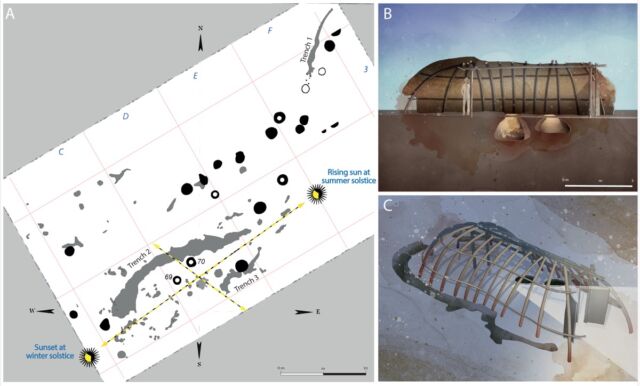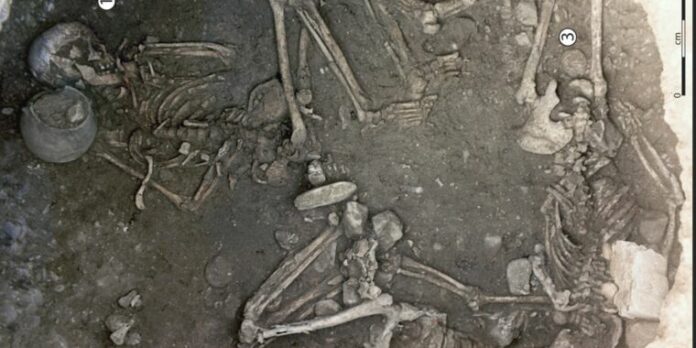. Beeching/Ludes et al., 2024
Archaeologists have discovered the remains of two women in a Neolithic tomb in France, with the positioning of the bodies suggesting they may have been ritualistically murdered by asphyxia or self-strangulation, according to a recent paper published in the journal Science Advances.
(WARNING: graphic descriptions below.)
France’s Rhône Valley is home to several archaeological sites dating to the end of the Middle Neolithic period (between 4250 and 3600/3500 BCE in the region); the sites include various storage silos, broken grindstones, imported ceramics, animal remains (both from communal meals and sacrifices), and human remains deposited in sepulchral pits. Saint-Paul-Trois-Châteaux is one such site.
According to Bertrand Ludes of the Université Paris Cité and his co-authors, the remains of the three women were found in Pit 69, a structure aligned with the summer and winter solstices, as was often the case in ancient agrarian societies. But the body positioning was decidedly atypical. One woman (No. 1), around age 50, was in the center of the pit, reclining on her side with a vase near her head. The other two bodies were just beneath an overhang. Woman No. 2 was on her back, legs bent, with a piece of grindstone placed on her skull. Woman No. 3 was in a prone position, knees bent, with her neck on the thorax of Woman No. 2 and two chunks of grindstone placed on her back.
The unusual positions imply a forceful, deliberate placement, according to the authors, suggesting they died in the pit rather than being tossed in after death. As for the cause of death, the archaeological evidence combined with recent forensic studies suggests “homicidal ligature strangulation” and “forced positional asphyxia”—at least for two of the three women. Woman No. 2, for example, would have struggled to breathe on her back, especially with the weight of Woman No. 3 pressing down on her neck (positional asphyxia), further exacerbated by the placement of the grindstone fragment.

Ludes et al., Sci. Adv. 10, eadl3374 (2024)
Woman No. 3’s prone position would mean she also would have struggled to breathe, and the volume of blood pumped by the heart would have sharply decreased, leading to cardiac arrest, a form of positional asphyxia now known as “prone restraint cardiac arrest.” All these clinical terms don’t quite capture the horrifically cruel nature of the manner of death. Given the placement of the woman’s knees—bent at more than a 90-degree angle, making the legs almost vertical—it’s possible she was tied up lying on her stomach, with the ligature connecting her ankles to her neck (similar to being hog-tied). In this position, “self-strangulation becomes inevitable,” the authors wrote, particularly if the mouth and nose are obstructed or there is cervical compression—say, from the strategic placement of grindstone fragments.
This form of torture, known as incaprettamento, has been used by the Italian Mafia, per Ludes et al., often to punish traitors, and dates as far back as the Italian Mesolithic era, “suggesting a highly ancient origin within ceremonial sites.” Sometimes, the victim would be strangled and the body tied up postmortem before the remains were disposed of. Ludes et al. believe Woman No. 3 would probably have been placed in the burial pit and tied up while still alive before self-strangling to death.
-
Reconstruction of the remains, blocked under the overhang of the wall of the storage pit lined with straw.
Ludes et al., Sci. Adv. 10, eadl3374 (2024) -
Reconstruction of skeletal remains for Woman No. 2 positioned on her back with bent knees.
Ludes et al., Sci. Adv. 10, eadl3374 (2024) -
Reconstruction of skeletal remains for Woman No. 3 in a prone position on her stomach with bent knees. The feet are behind the pelvis/toward the lower back, and the hands are tied behind the back.
Ludes et al., Sci. Adv. 10, eadl3374 (2024) -
Mesolithic rock art scene from the Addaura Cave is believed to depict ritual sacrifice by ligature strangulation (bolded figure).
B. Ludes et al., 2024
In fact, one scene from Mesolithic rock art found in the Addaura Cave in Sicily, Italy, seems to depict a ritual sacrifice by ligature strangulation. There are 11 human figures and the figure of a slain deer. Nine of the human figures form a circle, within which are the other two human figures (male, judging by the erect genitalia). Those figures are shown lying on their stomachs in a prone position, legs folded beneath them, with a rope stretched between their ankles and necks. The erect male genitalia, and one figure drawn with his tongue hanging out, are both signs of strangulation or hanging, per the authors.
It is notoriously difficult to distinguish between a merely violent death and one with ritualistic overtones when it comes to prehistoric remains. So Ludes et al. combed through existing literature for reports of similar cases. They found 20 cases of probable ligature strangulation or positional asphyxia in total across 14 different archaeological sites in Eastern Europe and Catalonia, spanning nearly 2,000 years. The individuals were found lying on their backs or sides, lower limbs flexed until the feet aligned with the pelvis, indicating hip extension. The oldest remains were found at sites in the Czech Republic and date back to between 5400 and 4800 BCE; the three women found at Saint-Paul-Trois-Châteaux are the most recent.
The latter site in particular has elements that “suggest a profound interconnection between religious systems and power structure in an agricultural society,” the authors concluded—namely, various structures aligned with summer and winter solstices indicative of an agricultural cycle and the placement of two women facing the central woman. It’s unclear why the women were sacrificed, the authors added, but such ritualistic sacrifice likely developed across central and southern Europe sometime in the Mesolithic and evolved over the course of two millennia before culminating in the late Middle Neolithic.
Science Advances, 2024. DOI: 10.1126/sciadv.adl3374 (About DOIs).


